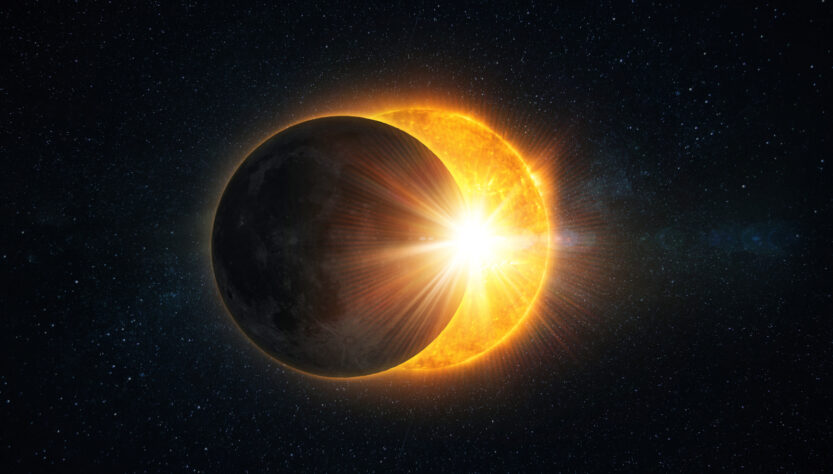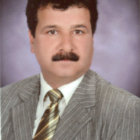Faculty of Education – Physics Education Department
On October 25th, 2022, the Astronomy Club at Tishk International University’s Physics Education Department will hold the third outdoor activity to observe the Solar Eclipse event in front of the Education Building. This partial solar eclipse is the second one of 2022 and is visible from most of Europe, northern Africa, the Middle East, and western parts of Asia. Solar eclipses have been observed throughout history, and ancient eclipse records made in Babylonia Clay Tablets, such as the one below:

Which are believed to be over 4,000 years old, providing physical records of ancient eclipses viewed by humans, in this instance, between BCE 518 and 465. The eclipse starts at one location and ends at another, and the times below are actual times (in UTC) when the eclipse occurs.
Eclipses and Major Belief Systems
Eclipses have been occurring on Earth since long before humans evolved. Throughout time, humans have had different interpretations of and reactions to these striking celestial events. The oldest recorded eclipse in human history may have been on Nov. 30, 3340 B.C.E. Different cultures in all civilizations respond to eclipses in different manners, so major civilizations had a more complex and evolved approach to eclipses. On this occasion, the Physics Education Department also presented a show with incredible different pictures of solar eclipses focusing on some other notable solar eclipses in history, along with historical artwork of people watching the total solar eclipse of 22 May 1724 and the very old records for the Mesopotamia, the plain between the two great rivers (Tigris and Euphrates, Iraq) in the dawn of civilization. There are records of astronomical observation which go back at least three thousand years, although they may have begun much earlier. Astronomy is, therefore, considered to be the oldest branch of science. The Egyptians, Sumerians, Babylonians, Chinese, Indians, and the Indians of Central America all made systematic written records of planetary movements, which enabled them to recognize the fundamental patterns on which they based their calendars. The earliest type was probably based on the cycles of the Moon. The knowledge that these cultures gathered helped in developing astronomical thought.
Solar Eclipses in History: A solar eclipse is a spectacular sight and a rare astronomical event. Next Partial Solar Eclipse will be on 29 Mar 2025.
On the afternoon of October 25th, the Moon will pass over part of the Sun, resulting in a partial eclipse that will be visible from the Erbil city and much of Europe. During this spectacular event, the Moon will cover part of the Sun, its silhouette taking a ‘bite’ out of the solar disc and producing a wonderful partial eclipse effect. This phenomenon will be visible from much of Europe, as well as North Africa, the Middle East, and western Asia. But remember, observing the Sun with the naked eye can seriously damage your eyesight, so proper solar glasses and filters or eclipse glasses must be worn.
Eclipse-watchers can expect to see the eclipse from around 10:00 BST (09:00 UT) until 12:00 BST (11:00 UT). And because this is not a total solar eclipse, part of the Sun will always be visible, which means that viewers will need to protect their eyesight while observing the eclipse and appropriate filter protection must be used to keep your eyes and equipment safe. The partial solar eclipse will be visible via the astronomy club with the aid of a telescope to watch this event. The live stream is presented by Mohammed and his team in the physics club. The eclipse won’t cover the Sun’s disc completely. From mainland UK, the greatest coverage will be 24.5% of the Sun’s disc at best. Images of the eclipse began circulating on social media and in live streams early Tuesday, with photographers posting photos from across Europe and the Middle East. Also, our students at physics education with the aid of the refracting telescope and UV solar classes watched this phenomenon with different students in IT, engineering, and pharmacy. They were able to get clear looks, revealing a full bite out of the sun.
Because the moon is smaller than Earth, the moon’s shadow covers only a small part of Earth’s surface and is visible only from certain regions. Because the moon’s orbit is slightly tilted, solar eclipses occur only when the moon crosses the plane of Earth’s orbit during a new moon. Eclipse windows happen six months apart (the last partial eclipse was in April). Solar eclipses can be especially dangerous because the sudden changes in luminosity do not give your eyes a chance to adapt.
In 2023, there will be two annular eclipses, which occur when the Moon, Sun, and Earth are exactly in line, but the moon is too far away to fully cover the sun, creating a bull’s-eye effect for observers. The first will be in April and will be visible from Northwestern Australia and Indonesia.
Precaution and Warning
Looking directly into the sun can lead to blindness and other forms of permanent eye damage if you aren’t wearing proper eye protection. For solar eclipses, always be sure to use proper equipment when observing the sun, and appropriate filter protection must be used to keep your eyes and equipment safe. Observers should use special protective eyewear or certified eclipse glasses. However, it is important to note that regular sunglasses will not protect you, even with UV protection. You should look for eclipse glasses that are ISO-certified, which means they’ve been approved by the International Organization for Standardization as safe for solar observing. That means they’ve been tested so that they do not let any more than 0.00032% of the sun’s light through their light filters, are free of defects like scratches or bubbles, can cover both eyes, and list the name of their manufacturers and instructions for proper use.
The safest way to observe a solar eclipse is to use indirect methods, like building a pinhole camera to project the eclipse on an external surface. Exposing your eyes to the sun without proper eye protection during a solar eclipse can cause “eclipse blindness” or retinal burns, also known as solar retinopathy. This exposure to the light can cause damage or even destroy cells in the retina (the back of the eye) that transmit what you see to the brain. So permanent eye damage can result from looking at the disk of the Sun directly, or through a camera viewfinder, or with binoculars or a telescope. The Sun’s surface still visible is about 10,000 times brighter than the full moon. Staring at the Sun under such circumstances is like using a magnifying glass to focus sunlight onto tinder. The retina is delicate and irreplaceable. There is little or nothing a retinal surgeon will be able to do to help you if you damage your eyes by looking at the Sun outside of the total phase of an eclipse without adequate eye protection. To observe the partial phases of a solar eclipse without damaging your eyes, there are several basic methods you can use, which we will describe below.
- The Pinhole Projection Method
One safe way of enjoying the Sun during a partial eclipse – or anytime – is to use a “pinhole camera,” which allows you to view a projected image of the Sun. While there are fancy pinhole cameras that you can make out of cardboard boxes, you can also make a perfectly adequate (and portable) version using two thin but stiff pieces of white cardboard.
- Observing with Binoculars
Optical binoculars can be used as a favorite instrument for observing total eclipses. Any size will do, but it is recommended to use 7 x 50 (7 times magnification with 50-millimeter [2-inch] objective lenses). It’s important to note that while observing the Sun outside of eclipse totality without a filter can quickly damage the unaided eyes, it is even more damaging to look at even a sliver of the uneclipsed Sun with binoculars that lack a filter.
When the moon is between the Earth and the Sun, it can cause a solar eclipse. However, the Moon’s orbit around Earth is tilted about 5 degrees with respect to the Sun, so the two do not align every new moon, which is why there is not a solar eclipse every month. We’ll have to wait until 2023 for the next time the Moon will cross in front of the Sun. There are two solar eclipses in 2023.
The next immediate solar eclipse will occur on April 20, 2023, and will be a so-called hybrid solar eclipse. This is an eclipse that can look like an annular eclipse, also known as a ring of fire solar eclipse, from some parts of its track and a total solar eclipse from others. This eclipse will be visible from parts of Southeast Asia, the East Indies, Australia, the Philippines, New Zealand, Indonesia, and Papua New Guinea.
The Effect of Solar Eclipse
According to NASA, there is no evidence that eclipses have any physical or chemical effect on humans. However, throughout history, eclipses have been known to have profound psychological effects on people. Past eclipses have also been known to change weather conditions in the U.S. and Britain. Temperature, humidity, and cloud cover all respond to the loss of sunlight. These changes are temporary, as the atmosphere usually recovers quickly. Total solar eclipses around the world make wildlife and domestic animals go a little loopy. The sudden mid-day darkness confuses them into doing their nighttime routines. Birds stop singing and go to roost, cows think it is night and head back to the barn, and some howling species start howling. Domestic cats and dogs can also act strangely.
The Main Benefits of Eclipses
Total solar eclipses provide an opportunity to study Earth’s atmosphere under uncommon conditions. The importance of this can be summarized as follows:
- This eclipse will also let scientists test equipment and instruments on the ground that they may someday want to fly into space.
- For scientists, eclipses offer a unique opportunity to study aspects of the sun like its corona, the layer of plasma surrounding the star. During a total solar eclipse, they can observe the corona’s features, such as the ejection of plasma from the sun’s surface.
- Recent solar eclipses have also proven to be a valuable tool for understanding the interaction between the Sun’s corona and the interplanetary medium.
- Recently, eclipses have been used to confirm the verification of Einstein’s general theory of relativity and to characterize the Sun’s atmosphere.
- Total solar eclipses show us the areas around the sun where all the action happens. This area is where the sun produces “solar weather” phenomena, like solar flares or coronal mass ejections.
- Solar eclipses have an impact on the rest of the solar system, including Earth. Solar weather and eruptions can also affect satellites and create hazardous radiation for astronauts in space.
- Solar eclipses enable scientists to measure accurately the diameter of the Sun and to search for variations in that diameter over long time scales. Geophysicists measure eclipse phenomena induced in the high terrestrial atmosphere.
Recommendation
The following recommendations should be considered by Tishk International University for the physics education department for future demands and can be summarized as follows:
- To ensure safe viewing of the solar eclipse event, it is preferred to have or purchase different types of special glasses and solar filters.
- To provide more than four or five types of educational telescopes for teaching and education for students (reflecting and refraction).
- To equip the physics education department with the newest type of faultless planetarium.
- To provide different types of illustrative maps and astronomical tools related to astronomy and astrophysics in the future.
Lastly, it can be seen that the scientific fascination with solar eclipses has led to some important scientific discoveries about the nature of the Sun, Moon, and our solar system.


